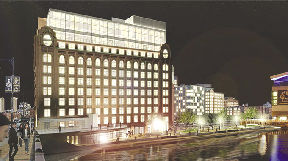Following nearly 100 years of haphazard exterior building modifications, and more than a decade of proposed redevelopment ventures, a significant waterfront parcel knitting together the city's North and West End is currently undergoing a major revitalization. In a joint venture between Beals Cos. and New-York based Related Cos., known as Related Beal, the conversion of the 2.1 acre property, currently under construction, is being designed for Converse, Inc., the sneaker manufacturer, as their new corporate headquarters.
The Architectural Team was selected by Related Beal to design Lovejoy Wharf's transformational conversion, ensuring a hybrid of architectural preservation with contemporary detailing.
This iconic building will offer flexibility and a public-spirited presence featuring ground floor retail and a waterfront pavilion. Its redesign will establish an epicenter connecting Charlestown, West End and North End neighborhoods—enlivening a once neglected and underutilized water-facing area of the city.
"The design approach for the 160 North Washington Street building represents a historically sensitive opportunity to achieve a complete rehabilitation of the existing structure combined with new construction, and provide for its long-term preservation and stewardship," says Michael Liu, AIA, principal at TAT. "Access is made easy by boat, bike, foot and public transportation, which will dramatically enhance the character and experience of Lovejoy Wharf, fostering a climate that creates a full breadth of waterfront activity. Making the most of the local identity, history and culture of this important landmark will stimulate widespread interest and create a unique sense of place."
Lovejoy Wharf was initially permitted in 2006 by TAT under both Boston's Article 80 Large Project Review as well as Massachusetts' rigorous Chapter 91 licensing process as a mixed-use/residential development for the site's former owner. Today, the conversion of the property involves the reuse of the existing nine-story Hoffman building and the new construction of a 50,000 s/f addition of commercial/retail space, a 7,600 s/f pavilion to provide a total of 220,000 s/f and a 40,000 s/f wharf structure. The wharf, despite its preeminent gateway location, had never offered public access.
"The redevelopment of Lovejoy Wharf presents one of the best opportunities for the public to reclaim an important portion of Boston's waterfront," said landscape architect, John Copley, ASLA, principal, Copley Wolff Design Group. "The site occupies a city gateway location. The design, which fosters adaptability, will make Lovejoy Wharf an exciting place to dine, work, and play—featuring amenities that increase people's comfort and enjoyment year-round."
Copley Wolff's design includes a park/ plaza space along the waterfront which will provide a link to the North End and enhance pedestrian access to the Charles River Dam. The scope includes raised planters with trees, shrubs, and a green space; a harborwalk along the water; and a large pedestrian stair from the Washington Street Bridge to the pier below. There will also be interpretive elements highlighting the history of the site and a large-scale wayfinding marker which will act as a gateway to the Harborwalk and Charles River Basin parks.
Additionally, according to Converse, its non-profit arm Converse Rubber Tracks—a state-of-the-art recording studio—will open on the Lovejoy plaza. The full-service recording space will provide artists of all genres the opportunity to record their original music at no cost alongside a team of experienced engineers.
"Boston is indeed in the midst of an essential process of rediscovering, redefining and re-enlivening its urban waterfront," adds Liu. "The continued investment in the waterfront for varied uses, such as Lovejoy, will help revitalize and improve upon the incredible public amenities that the City's coastline offers."
TAT has completed other notable Boston waterfront developments including Commercial Wharf—an historic conversion of a former shipping warehouse into 80 luxury condominiums (1986); Lincoln Wharf—the first historic conversion in the U.S. of a former MBTA electrical power plant into 191 luxury condominiums (1987); the adjacent property Battery Wharf—the new construction of a five-star 150 room hotel and 104 luxury condominium development with restaurant/retail/health spa, a Maritime Museum, and a 70,000 square foot waterfront pavilion (2008); and Building 114, located along the harborwalk in Charlestown's Navy Yard—an historic conversion of a former Navy joinery shop into a new biomedical research laboratory (2001).
Tags:
The Architectural Team selected by Related Beal to design 2.1 acre Lovejoy Wharf for Converse, Inc. headquarters
November 21, 2013 - Front Section









